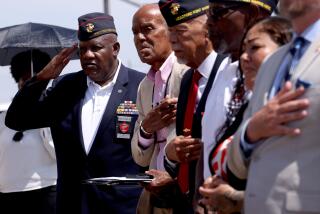NEWPORT BEACH : Cameraman Now Shoots for Police
- Share via
He may have left Hollywood behind, but there’s been no shortage of drama in Jan Anderson’s life since the former television cameraman became a full-time video producer for the Newport Beach Police Department.
Anderson, 47, says he filmed such programs as ABC’s “Nightline” and “20/20” and snagged four Emmys before he switched careers a year ago.
The former reserve officer and police academy graduate who never became a cop said the transition to his latest duties, which include taping crime scenes and accidents, has been surprisingly smooth.
“I have a camera in one hand and a gun in the other,” he said.
It was almost five years ago when Anderson, then a reserve officer, began creating the Police Department’s video unit. Since the department created a full-time job for him last summer, he has videotaped scenes of plane crashes, chemical and oil spills, accidents and murders.
Anderson captures crime settings on tape for use in investigations and produces officer-training films.
In his office this week, Anderson reviewed what he considers the most dramatic footage he has shot for the police department. Flashing to life on the small screen is the tense aftermath to a murder in February during which a man shot his ex-wife to death before fatally shooting himself.
In that double-slaying, Anderson’s $43,000 camera recorded a SWAT team car as it pulled in front of a home in the Lido Peninsula mobile home park. A young woman’s body was sprawled in the street. The gunman was out of sight in an adjacent home, Anderson said.
As the car edged nearer the woman, an officer rushed from the car and pulled her inside. She was already dead.
The cameraman was also called to the scene Sept. 1, 1988, just moments after a drunk driver struck and killed a Balboa Peninsula woman who was standing in an alley with her two young sons. A video camera, which a passenger in the suspect’s car had been using, was found in the vehicle, Anderson said, but officers were told it was blank. He took the camera, rewound the tape until it clicked off, started it, and discovered nothing but static.
But the next day, Anderson picked up the camera again.
“I started playing with it,” he said. “I was really just basically looking for some audio.”
But suddenly, images began to appear on the viewfinder. First, visions of activities which took place the day before the accident. Then, Debbie Ann Killelea’s last day of life sprang into view.
“I almost did a back flip out of the chair when I saw it.”
The tape became the central piece of evidence in the trial against 19-year-old Danny David Ornelas, who was convicted of gross vehicular manslaughter and sentenced to 10 years in prison.
Anderson was also at the scene a year ago shortly after a water line ruptured along Coast Highway and a blast of water forced a construction worker down a storm drain to sudden death. The camera continued to run as lifeguards in wet suits went into the pipe and retrieved the man and paramedics attempted to revive him.
Although he is paid to “document arrests, not make them,” Anderson says his presence can benefit the officers.
“When you go crashing into a house, the camera and lights are such a distraction, the bad guys don’t expect that,” he said. “It makes them think twice before they do anything, and usually, before they think twice, they’re already caught.”
More to Read
Sign up for Essential California
The most important California stories and recommendations in your inbox every morning.
You may occasionally receive promotional content from the Los Angeles Times.













